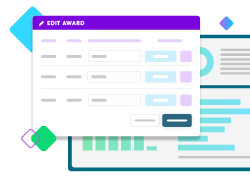5 Trends in Grantmaking that We Think Have Staying Power

Sometimes trends are purely of the moment—a fun way to mark the past, like shag carpet and 8-track tapes. But sometimes trends are the beginning of an idea, just starting to take shape, that will become the norm in a few years or a few decades. This is why it’s important to keep an eye on the trends impacting the philanthropic industry, and incorporating the ideas that make sense for your organization.
From community involvement in your grantmaking decisions to better ways to think about risk, the current trends in grantmaking can help you make more effective decisions and more clearly tell your impact story.
Here is a breakdown of five trends in grantmaking that we think are the start of a new way of thinking.
1. Focusing on Workplace Wellness for You and Your Grantees
While it’s safe to say that no one wants another worldwide pandemic anytime soon, we did learn a lot about workplace wellness and the effects it can have on people dedicated to making the world a better place.
As we get back to in-person events and get comfortable with hybrid working, we’re also seeing the stigma around mental illness and burnout fade. Possibly because most people experienced a level of anxiety and overwork during that time, so more people had a glimpse at what others deal with regularly.
More than just about any other industry, it’s easy for people working in the nonprofit space to burn out because they are so dedicated to helping others. We are seeing grantmakers step up for both their teams and their grantees to make mental wellness a priority. It can be as simple as setting boundaries on the number of video meetings a staff member should be in each day to taking actionable steps to be more transparent with grantees on timelines.
For more on how to incorporate wellness best practices into your grantmaking organization, check out our blog post, “Workplace Wellness for Grantmakers and the Nonprofits They Support.”
2. Rethinking Risk with Trust-Based Philanthropy
The ideas behind Trust-Based Philanthropy have been simmering for a while, but a culmination of events over the past few years makes now the time for them to gain some traction. And it starts with funders re-thinking risk. As Satonya Fair, CEO of PEAK Grantmaking, wrote for the ENGAGE blog, the goal of your foundation shouldn’t be to protect your organization’s treasure at all costs. It should be to make an impact and support nonprofits that align with your mission.
No one is suggesting that funders run their coffers dry by giving money to every organization that comes asking. With Trust-Based Philanthropy, you focus on truly understanding the needs of the nonprofits you work with. When you’ve built strong relationships and have solid non-financial supports in place, you can enable your grantees to be more effective and impactful. This can look like a streamlined application process—or no application process—for long-standing grantees or networking opportunities to help your young leaders connect with more seasoned nonprofits.
For more ideas on how to build trust with your grantees, check out our blog post, “Achieving Lasting Impact Through Trust-Based Philanthropy.”
 Free Resource
Free Resource
Tips for Stewarding Responsively
3 Ways to Redefine Risk and Build Stronger Relationships with Your Grantees

3. Getting Closer to Your Community with Participatory Grantmaking
Nonprofit organizations such as Maine Initiatives have been using Participatory Grantmaking for years to distribute the decision-making power to people closest to the problem. Along with the principles of Trust-Based Philanthropy, the themes of sharing power and building community relationships make Participatory Grantmaking something we expect to see more of over the next few years.
There are several benefits to adding participatory grantmaking to your funding programs. For example, bringing your community leaders closer to the decision-making process creates more effective grant programs. These community leaders work on the problem you want to address every day, and they see the efforts that work first-hand. Bringing these voices to the decision-making table helps you better identify opportunities you might not have recognized.
Participatory grantmaking does require a mindset shift. As a funder, you are giving control over who is awarded grant money to these members of your community. This isn’t a focus group or recommendations for you to approve. So, for some grantmaking organizations, they often start with one program and expand from there.
To learn more about participatory grantmaking, how to get started, and examples of other organizations using this model, check out our post, “Bring Your Community into Your Decision Making Through Participatory Grantmaking.”
4. Protecting (and Communicating) Your Impact Story
Data security will continue to be a focus area for any organization that collects information about the people they work with. It will take consistent monitoring and updates to make sure you stay ahead of the people who would try to steal that information.
But good data security is about more than keeping your information safe. Having clear and accurate data—and knowing where it’s located—can help you communicate a strong impact story. By taking steps to understand the information you have about your grantees, you can better protect them and communicate the impact your organization is having on your community.
Not communicating the information you know about those you serve for the sake of data privacy doesn’t help you or your grantees. As technology evolves, journalists and researchers will often find bits and pieces and may make inferences out of context. Or worse, assume you are not making an impact at all. Be proactive by understanding the data you have, what is sensitive and what can be shared, and telling your own impact story through your website and your 990-PF.
For more tips on data security for grantmakers and telling your impact story through your 990-PF, check out our blog post, “Don’t Leave Your Foundation’s Impact Story to Chance.”
5. Continuing Your Journey of Diversity, Equity, and Inclusion
While we’ve seen a lot of progress in diversity, racial equity, and inclusion in philanthropy, the journey is far from over. But it’s clear that establishing a grantmaking organization that centers diversity and inclusion enables you to more effectively reach and respond to the needs of a more diverse community.
Regardless of your impact area, the people you serve are getting more diverse. The leaders of the nonprofits you support are getting more diverse. And you are probably seeing your own staff getting more diverse. So, we are seeing DEI efforts move from a box to be checked to the realization that this is an evolving process.
This trend is not a new idea or even an idea that is only a few years old. The trend for diversity and inclusion is understanding where you are on your journey and finding the next step. Because there will always be a next step.
To learn more about how other grantmakers are finding and taking that next step, check out our blog post, “Putting Equitable Grantmaking into Practice.”
Create a Solid Foundation to Stay Flexible
Philanthropy is not immune to the impact of advancing technology, shifting demographics, and social change. But in order to critically evaluate and implement important elements that these movements bring, your grantmaking organization must have a solid foundation. This includes a strong and relevant core mission, staff ready to try new processes, and an adaptable grants management system.
Manage your entire grantmaking workflow, from online grant applications through payments
Find out how Blackbaud Grantmaking™ fits your organization.

